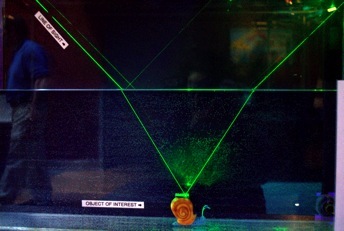The University of Vermont
Physics Department


The University of Vermont
Physics Department
Refraction

Here a laser beam enters the water from the left, bounces off a snail with a mirror on its shell and exits the water to the right. This is an example of light traveling from a lower index of refraction (higher speed) to a higher index (slower speed) and back to the lower index. Photo by Madelina Furis, University of Vermont Physics Department
In the picture to the left water waves are projected onto a screen with the waves traveling from bottom to top. In the center of the tank is a rectangular piece of Plexiglass that changes the depth of the water and also the speed of the water wave. The wavefront lags in the shallower water where the index of refraction is higher.
A glass rod with is partially submerged in vegetable oil. Since the index of refraction of the rod and the oil are almost exactly the same, the rod “disappears” in the oil.


Photo by David Hammond, University of Vermont Physics Department.
Photo by David Hammond, University of Vermont Physics Department.